
Clemens Tremmel Archipel
Leipzig 9 Sep – 19 Dec 2017
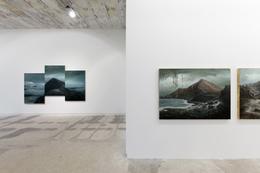
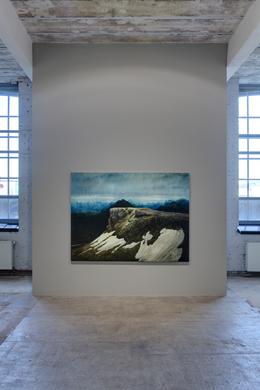
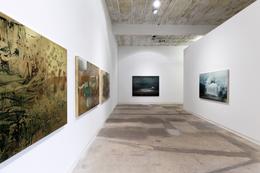
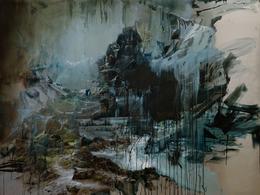
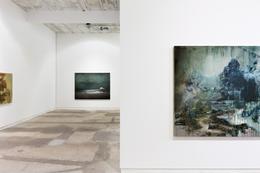
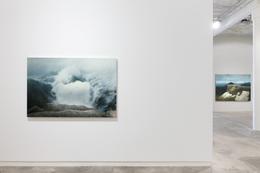
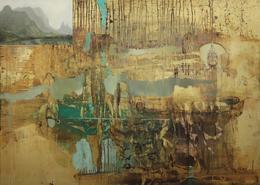
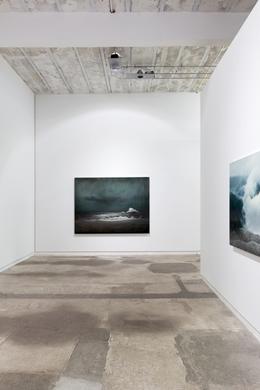
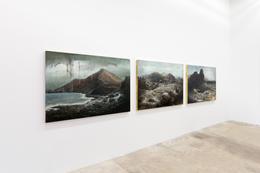
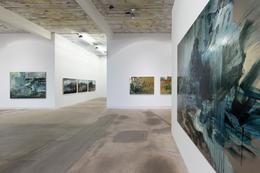
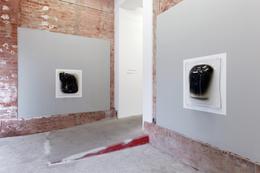
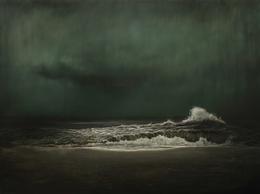
The art of Clemens Tremmel follows the trace of the thing to be watched. To that end, he has built traps for the eye into his painting from the outset. Early works have rectangular windows, are covered and nailed shut with metal, scratched and torn out, taken apart and reassembled, even charred. Painting should not be limited to the visible is his imperative. The culture of the momentary, our everyday visual culture, reverberates here; in order to see through to what is in back, resistances have to be overcome; we have to see our part into it. In front of Tremmel’s paintings, we become viewers, vaguely sensing a state that is supposed to parallel the artist’s creative process.
It is based on an understanding of nature that is not of this time; it is categorically distinct from the concern for the environment of contemporary art. Tremmel translates the forces of nature into the painterly. There they seem familiar because they have an effect inside us as well. He links to the landscape a visual tradition that these days is essentially left to photography, and he knows how to triumphally juxtapose the rationally restricted oculus of the photographic with the formative principle of painting. In the meanwhile, he has developed painterly modes for it that form an archipelago of the islands that he visits and that have inspired him to do so.
By analogy to the enormous physical processes that he learned from Iceland as his Kythera of the north, Tremmel scratches, wipes, chops, squeegees, scrapes, and paints what cannot be done on any canvas, which accounts for the more rugged supports of artificial wood, metal, acrylic glass. In an almost geological process of application and erosion of paints and emulsions, a pictorial space results in which the landscape condenses and is contoured by cold backlighting. In the most recent works, whirls of pigment shoot into this dense display of nature, through the space onto the surface—a painterly equivalent of the invisible, which Tremmel is no longer concealing. Unlike the Geysir in Iceland, whose roaring, bluish-white, volcanically induced blasts of water force may have prefigured this, his painting gestures persevere in the painterly space and develop material qualities there. They are manifestations of creative ecstasy. This profligate, mysterious elemental force, whose effect occurs, as it were, behind the visible aspect of nature and of art, comes to the fore in these works.
The circle of islands has expanded in the meanwhile; the northern islands have been joined by southern and Far Eastern ones. There is a corresponding shift in coloration, playfully breaking with the canonic dark, cool palette of the northern nature, which points to the sublime. But these works are not about impressions; rather, the distance works like a catalyst for painterly methods that Tremmel seems to be open up from afar for his work in his studio in Leipzig. For after nature challenges the painter to create, now culture in the form of history enters the scene. Here too he sets out from the vedute, the tourist’s gaze, only to force to the margin: with ornament, writing, with the symbolic, with pure painting. Tremmel once again exceeds the limits of the image by not recognizing that an image is only supposed to be one image. Whereas the “northern” paintings were still playing with unified pictorial space, in the “eastern” ones it has given way to a pluralism that can only be accessed successively. As a result, a narrative quality weaves its way into the time of observing. However sensational the diversity fanned out before us might seem, the artist holds the elements together aesthetically in a masterly way: usually by means of contour-like lines overwritten on the format like a large signature.
As if the many were not enough, in his recent paintings Tremmel has found his way into the Delian temple of his archipelago, so to speak, and evoked by means of the gleam of brass that now serves as his support an ancient artistic formula of evocation familiar to him from Russian icons. The gold ground, the Byzantine splendor, which makes the background seem motionless, combines with the plasmatic vortex to become the prima materia of painting. The painter is recovering for Western painting something it had long since abandoned. This ancient glow of what is to be seen is rarely visualized so undogmatically, but Clemens Tremmel’s art radiates it.
Dr. Ulf Jensen (excerpt from catalogue Clemens Tremmel »Archipel« 2017)
It is based on an understanding of nature that is not of this time; it is categorically distinct from the concern for the environment of contemporary art. Tremmel translates the forces of nature into the painterly. There they seem familiar because they have an effect inside us as well. He links to the landscape a visual tradition that these days is essentially left to photography, and he knows how to triumphally juxtapose the rationally restricted oculus of the photographic with the formative principle of painting. In the meanwhile, he has developed painterly modes for it that form an archipelago of the islands that he visits and that have inspired him to do so.
By analogy to the enormous physical processes that he learned from Iceland as his Kythera of the north, Tremmel scratches, wipes, chops, squeegees, scrapes, and paints what cannot be done on any canvas, which accounts for the more rugged supports of artificial wood, metal, acrylic glass. In an almost geological process of application and erosion of paints and emulsions, a pictorial space results in which the landscape condenses and is contoured by cold backlighting. In the most recent works, whirls of pigment shoot into this dense display of nature, through the space onto the surface—a painterly equivalent of the invisible, which Tremmel is no longer concealing. Unlike the Geysir in Iceland, whose roaring, bluish-white, volcanically induced blasts of water force may have prefigured this, his painting gestures persevere in the painterly space and develop material qualities there. They are manifestations of creative ecstasy. This profligate, mysterious elemental force, whose effect occurs, as it were, behind the visible aspect of nature and of art, comes to the fore in these works.
The circle of islands has expanded in the meanwhile; the northern islands have been joined by southern and Far Eastern ones. There is a corresponding shift in coloration, playfully breaking with the canonic dark, cool palette of the northern nature, which points to the sublime. But these works are not about impressions; rather, the distance works like a catalyst for painterly methods that Tremmel seems to be open up from afar for his work in his studio in Leipzig. For after nature challenges the painter to create, now culture in the form of history enters the scene. Here too he sets out from the vedute, the tourist’s gaze, only to force to the margin: with ornament, writing, with the symbolic, with pure painting. Tremmel once again exceeds the limits of the image by not recognizing that an image is only supposed to be one image. Whereas the “northern” paintings were still playing with unified pictorial space, in the “eastern” ones it has given way to a pluralism that can only be accessed successively. As a result, a narrative quality weaves its way into the time of observing. However sensational the diversity fanned out before us might seem, the artist holds the elements together aesthetically in a masterly way: usually by means of contour-like lines overwritten on the format like a large signature.
As if the many were not enough, in his recent paintings Tremmel has found his way into the Delian temple of his archipelago, so to speak, and evoked by means of the gleam of brass that now serves as his support an ancient artistic formula of evocation familiar to him from Russian icons. The gold ground, the Byzantine splendor, which makes the background seem motionless, combines with the plasmatic vortex to become the prima materia of painting. The painter is recovering for Western painting something it had long since abandoned. This ancient glow of what is to be seen is rarely visualized so undogmatically, but Clemens Tremmel’s art radiates it.
Dr. Ulf Jensen (excerpt from catalogue Clemens Tremmel »Archipel« 2017)
Artists